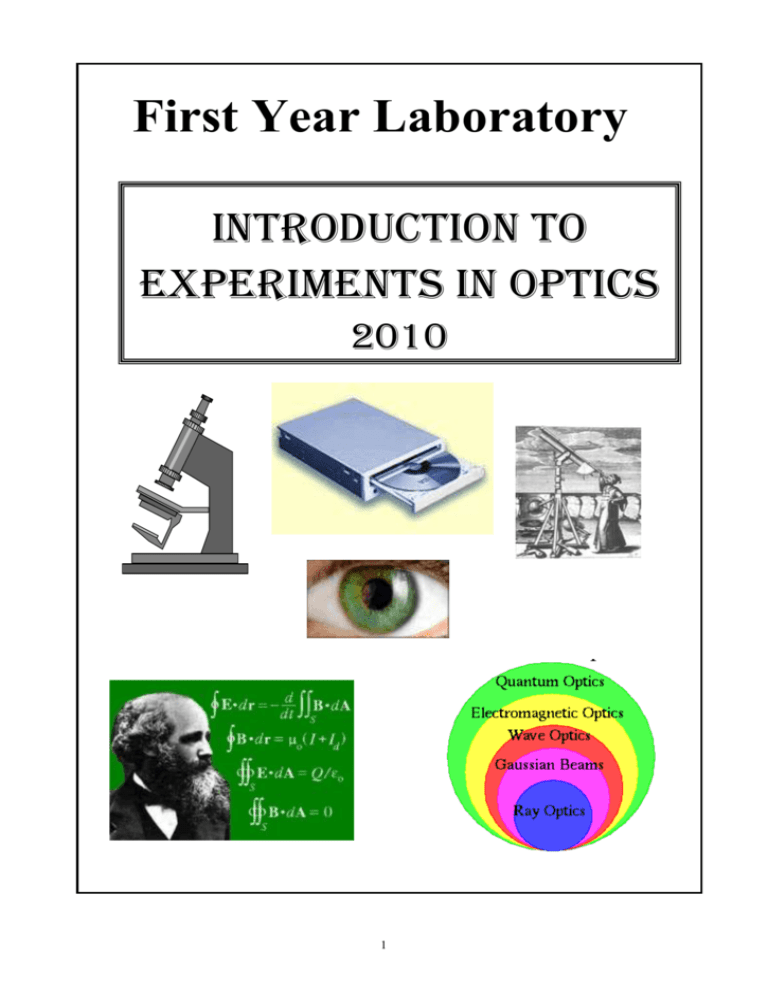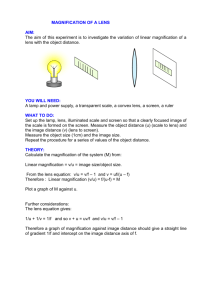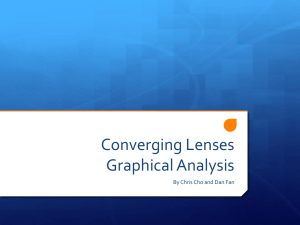Introduction To Optics
advertisement

First Year Laboratory Introduction to Experiments in Optics 2010 1 Introduction to Experiments in Optics Welcome to Introduction to Experiments in Optics. In this introductory session, you will perform some simple experiments that will develop some key experimental skills and illustrate the ray and wave nature of light via two experimental systems: A. Thin Lens Imaging (Ray Optics) B. Single-slit diffraction (Wave Optics) A. LENS IMAGING (RAY OPTICS) In this experiment, you will study the imaging properties of a lens using some basic methods and formulae as applied to imaging systems. Ray Diagrams. Figure 1 is a ray diagram that illustrates the object distance s, the image distance s’, all measured from the centre of a thin converging lens with focal length f. When drawing ray diagrams, it is convenient, as shown in Fig 1, to use the 3 principal rays constructed as follows: A ray passing through the centre of the lens is undeviated. A ray directed parallel to the optical axis passes through a focal point. A ray passing towards, or away from, a focal point emerges parallel to the axis. It is useful to denote the front and back focal plane (F and F’) of the lens on the diagram. Any two of the principle rays will allow you to locate the image (the third can be used as a cross-check). ho F’ O I hI F s’ s f f The image point is where the principle rays cross. Figure 1: Principal rays used to locate the image formed by a converging lens. Lens Formulae. For small angles, the thin lens formula and the linear magnification can be derived from the ray diagram. The thin lens formula is: The linear magnification m is given by m s . s 1 1 1 s s f (1) (2) EXERCISES 1.1. Lens formulae. An object is placed 150mm from a 100mm focal length lens. Use the thin lens formula to calculate the image distance. What is the magnification? Comment on the significance of the negative sign in the calculated magnification. 1.2. Locating Image and Magnification by Ray Diagram. Construct a ray diagram of the previous exercise using a scaled drawing in your lab-book. Choose a suitable scaling to fit diagram in your lab-book. Draw two principle rays and hence locate image location. (Check with the third principle ray). Measure image distance on your scaled diagram and rescale to determine the image location (s’). Measure the linear magnification by comparing the heights of the image and object (hI/hO). 1.3. 2 Experimental System 1. Imaging with a lens. Experiment 1.1 Experimental Imaging. Figure 2 shows a simple set-up for imaging with a positive focal length lens. Use the slide with a single letter as an object in the slot-holder in front of image, observed on ground-glass screen f object Light source view from behind screen s’ s Figure 2: Experimental system for imaging with a positive lens. the light source. Use the plano-convex lens of nominal focal length 100mm. Place the lens 150mm from the object (use your meter rule to measure this). Observe the image of the object slide on the ground-glass screen by looking at the back of the screen and adjusting its position for sharpest image. It may be difficult to see the image until you are close to the image plane. Use your meter ruler to measure as precisely as you can the image distances of your system. Also measure the size of one of the dimensions of the object and its corresponding size in the image plane. Estimate an error for each of the measurements you make. Use your object and image size to calculate the experimental linear magnification with associated error. Compare your experimental results to your calculations in Exercise 1.1. Experiment 1.2 Measuring the focal length of a lens. Figure 3 shows a simple method for measuring the focal length of a positive lens. mirror lens object Light source f Figure 3: Simple method for estimating focal length of a positive lens. Switch on the light source – the voltage on the supply should be at voltage 5V (max.). Use the slide with a pin-hole as an object in the slot-holder in front of the light source. Use the plano-convex lens of nominal focal length 100mm. Adjust the height of the lens to get the transmitted light to run parallel to the bench and if necessary tilt the lens so it is at right-angles to the optical axis. Place the mirror on the optical rail to reflect the light back onto the pin-hole slide (just to the side of the pin-hole itself). You should observe that the size of the reflected beam varies as you move the lens along the bench, but there is a position where it is a minimum. This position occurs when the lens is at the focal length from the object. (Check to see if the return spot is affected by the position of the mirror.). Use your meter ruler to measure this distance as precisely as you can, taking your measurement to the centre of the lens. Make an estimate of the error. Ensure you record your measurement of the focal length with associated error in your lab-book. 3 B. WAVE OPTICS – SINGLE-SLIT DIFFRACTION The aim of this experiment is to observe the far-field diffraction patterns obtained when a laser illuminates an aperture. Experimental System 2: Diffraction by a Single Slit bi-convex lens f=1000mm observing screen LASER f diffracting object Figure 4: Basic arrangement for visual observation of diffraction patterns. Visual observations are made on the screen in the focal plane of the lens: DO NOT STARE DIRECTLY INTO THE LASER BEAM! (i) Figure 4 shows the basic set-up for visual observations. In this experiment, the light source is a diode laser emitting at a red wavelength of 670 1 nm. This laser is powered by a special stable 5 volt power supply. Use the variable width slit as the object. Set the slit width visually to about 1.0 mm and place it immediately after the laser output. [You can centre the laser on the slit by loosening the laser’s post and rotating it slightly.] Observe the diffraction pattern on the screen placed 1 m from the 1000mm focal length lens. Now slowly close the slit, and observe and note in your lab book the change in the diffraction pattern. Set the slit width such that the width of the central maximum is approximately 10mm. Draw a labelled sketch (with a scale marked) of this diffraction pattern, noting your visual estimate of the slit width. According to theory, the “far-field” intensity diffraction pattern I(x) of a single slit of width a, as a function of distance x in the observation plane is given by sin ax I( x ) I 0 axf f 2 (3) where I0 is the intensity at the centre, is the wavelength and f is the focal length of the focussing lens. From this equation, the zeros of intensity occur at x-coordinates xm = m(f/a) m 1, 2, 3 .... Does the single slit diffraction pattern you see with your eye look as though it is described by equation (1)? Are the "zeroes" of intensity correctly spaced, given the slit width that you used? According to the equation, the first secondary maximum has an intensity that is about 4.5% that of the central intensity. Does that agree with your visual impression? Make these observations carefully and critically: keep a clear and accurate record in your lab book. (ii) In this last part of the experiment, the aim is to produce quantitative measurements of the intensity. To measure the intensity a photodiode is used together with a narrow slit (=100 m) in front of it. The photodiode output is a voltage that is linearly proportional to the light intensity. The slit/photodiode are provided as a single unit that attaches to a precision translation slide (the slit/photodiode can be rotated by loosening the screw on the mounting bracket of the translation slide). The translation slide has a total range of 25 mm. 4 bi-convex lens f=500mm Photodiode/slit on translation stage LASER f diffracting object voltmeter Figure5: Basic arrangement for measurement of the intensity of diffraction patterns. The object is placed close to the laser output and the f = 0.5 m lens immediately follows. The slit in the photodiode assembly is placed 0.5 m from the lens. Use the set-up shown in Figure 5. For this experiment, use the slide marked "Single Slit". The exact width of this slit is not known but it is about 60 m. Compared to Figure 4, the only significant change is that the 1.0m focal length lens has been replaced by the 0.5 m focal length lens and the observing screen is replaced by the photodiode assembly. First, find the centre of the diffraction pattern (the largest intensity) and note the voltage reading and the position on the micrometer scale of the translation stage. [You should choice the best scale on the voltmeter (either 2 V FSD or 200 mV FSD).] Secondly, try scanning the photodiode quickly across the intensity pattern and note the general shape. Find the first secondary maximum and compare its magnitude to the central maximum. Finally, find the positions of the first “zeroes” (m= 1). Hence estimate the slit width with an error value. 5







